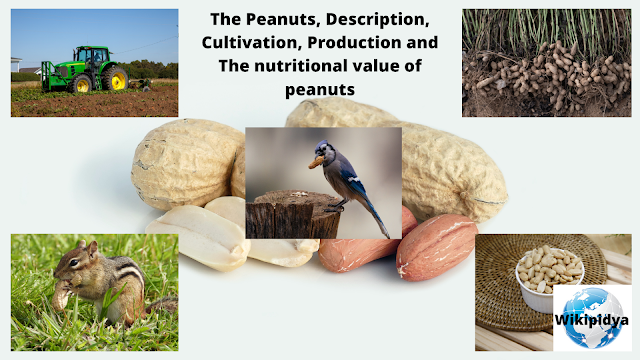The Peanuts, Description, Cultivation, Production and The nutritional value of peanuts
The Peanuts
Description of the Peanut
Peanuts are legumes from the pea family (Fabatsia) known as groundnuts, sometimes known as groundnuts, pistachios, or jojoba, for their edible seeds. Peanuts, a native of tropical South America, were first brought to the tropics in the early Old World. The seeds are a meal rich in nutrients and high in fats and proteins. Peanuts are not a true nut, despite the fact that they have several names. The plant is particularly useful as a soil fertilization crop because, like other legumes, it uses nitrogen-fixing bacteria to supply nitrogen to the soil.
Cultivation of the peanut
Annual peanut production. It can have a spreading form with long branches low to the ground or an erect shrub 45-60 cm (18-24 in) high with short branches. Feathered compound leaves have two pairs of leaflets and are borne on strong, hairy stems. There are 10 mm (0.4 in) diameter golden yellow petals on the inflorescence, which are produced in the leaf axils. With two or three seeds and an average length of 25–50 mm (1–2 in), the oblong pods are usually pressed between the seeds and have a thin, woven, spongy shell. The seeds are oblong to semi-spherical in shape and have a papery seed coat that is either white or dark purple in color.
During the growing season, peanuts require a minimum of five months of warm weather with at least 60 cm (24 in) rainfall (or equivalent irrigation). The best soil is a well-drained sandy loam topped with a deep friable (easy to collapse) subsoil. The plant is completely dug out of the ground during harvesting, except for the deep roots. Harvested plants are often allowed to wilt for a day before being stacked around a sturdy stick and buried in the ground upright in the ground for four to six weeks to cure the pods. To keep them out of the elements, capsules are placed inside each pile.
The peculiar tendency of groundnut legumes to ripen is known as geocarpy. A strange stem-like structure known as a wedge emerges from the base of the blossom toward the ground after pollination and the blossom wilts. The strong end of the dowel holds the fertilized eggs until they are deep below the soil surface, at which time they begin to transform into the characteristic capsule. Before the tips of the wedges produce fruit, they should occasionally drop by 10 cm (4 in) or more. These exotic fruits look almost like roots, absorbing minerals and nutrients straight from the ground. No matter what nutrients are accessible from the roots, pods may not develop properly if the soil around them is not adequately supplied with calcium.
Peanuts are often used to make an edible oil with a high smoke point that is marketed as boiled or roasted. The seeds are commonly used in candy and baked goods in the United States and are also processed into peanut butter. In some areas, peanuts are widely used as animal feed. When the pods are harvested, the tops of the plant are often fed as chaff, although the whole plant can be used in this way.
Production of the Peanuts
The annual production of groundnuts is 48,756,790 tons worldwide.
China comes as the first groundnut-producing country with an annual production of 17,572,798 tons, followed by India in second place with an annual production of 6,727,180 tons and Nigeria follows as the third-largest producer of groundnuts with an annual yield of 4,450,050 tons.
China, India, and Nigeria together produce more than half of the world's total production of peanuts.
With an annual production of 2,492,980 tons, the USA is ranked fifth.
The nutritional value of peanuts
Many people think that tree nuts like cashews, almonds, and walnuts are more nutritious than peanuts. However, peanuts should not be disregarded as a healthy diet because they have many of the same health advantages as the more costly nuts.
The main ingredients that makeup peanuts include protein, lipids, and fiber. These elements are all present in their most advantageous configurations. It has been shown that plant-based protein, unsaturated fat, and complex carbohydrate fiber are the finest sources of nourishment for people.

